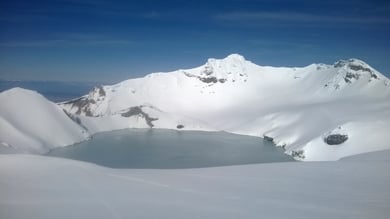Volcanic risk downgraded for Ruapehu’s summit craters area
Archived content: This media release was accurate on the date of publication.
Introduction
DOC has cancelled the advisory for people to take extra caution trekking up to Ruapehu’s Crater Lake.Date: 10 November 2015
Cooling temperatures in the Crater Lake in August had created uncertainties about the state of the vent system under the lake. As a result of this, DOC noted that there was a small chance a minor eruption might occur and recommended to climbers, and others visiting the summit area, that they should minimise their time in this area and in the upper parts of valleys on the mountain.
 Ruapehu Crater Lake
Ruapehu Crater Lake
Subsequent monitoring by GeoNet and GNS Science, including sampling and analysis of water and gas from the Crater Lake, have clarified the situation.
Measurements also show that the temperature in Crater Lake has now warmed a few degrees.
“The monitoring data is reassuring and consistent with what we have learnt about Ruapehu in the last 20 years”, says Dr Harry Keys, Technical Advisor-Volcanology at DOC.
“However we have also learnt Ruapehu continues to be one of the more unpredictable volcanoes, which is why we issue such advisories when there is extra concern for public safety”, he said.
The volcanic risk advisory signs, erected with the support of iwi, have now been removed from around the volcano.
Normal operations continued for visitors to all areas outside the summit craters and upper valleys during the advisory. “Operations at all three ski areas, roads and areas surrounding the mountain were not affected”, says Paul Carr, Conservation Services Manager.
DOC recommends no-one ever camps within a kilometre of the Crater Lake.
The level of unrest at Mount Ruapehu is continually monitored by GNS Science to ensure any changes in the volcanic state are detected at the earliest possible time and communicated to DOC and Ruapehu Alpine Lifts so appropriate procedures can be put in place. The volcanic alert level for Mount Ruapehu remains at Level 1 (minor volcanic unrest).
Background information
On 21 August 2015 DOC recommended a precautionary approach was taken by climbers and others planning to visit the summit area of the mountain because of uncertainties about the state of the vent system under Crater Lake.
At the time the following restrictions applied:
- no people within 400 m of the Crater Lake
- do not go past Whakapapa Col or the Dome Shed or enter into the crater from above Turoa ski area
- do not camp in the summit area
- do not linger in the bottoms of valleys in the Whangaehu and Whakapapaiti catchments away from the public warning systems.
Most of these recommendations are consistent with the normal precautions for people to minimise the time spent in the crater basin area and avoid camping within a kilometre of any active vent in the National Park.
DOC and GNS continue to monitor the situation at the Crater Lake.
Contact
Harry Keys, DOC Technical Advisor Volcanology, Turangi
Phone: +64 7 376 2549
Paul Carr, Conservation Services Manager, Whakapapa
Phone: +64 7 376 2549
